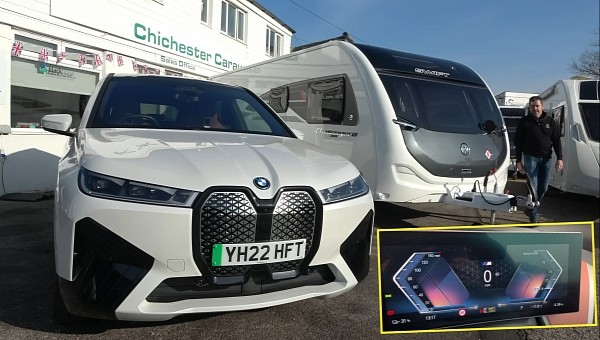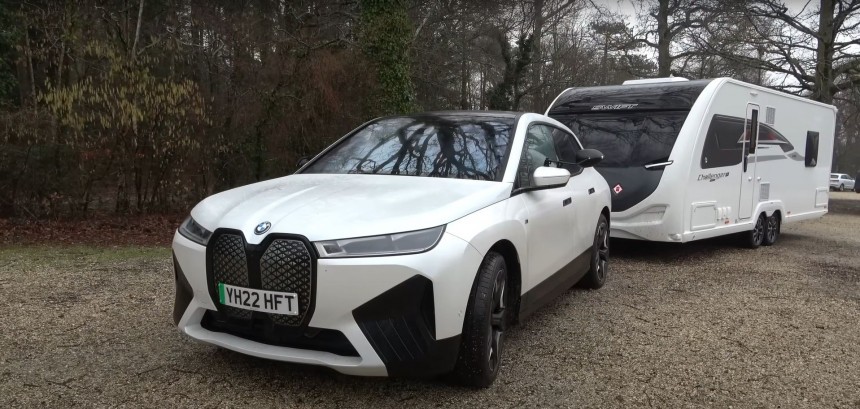The BMW iX M60 is the Bavarian automaker’s way of showing everyone that it can do battery-electric vehicles (BEVs) well, especially when they are built from the ground up as zero-tailpipe emission units. It’s also BMW M’s first attempt at turning a “purebred” BEV into a better-performing colossus. The i4 M50 does not count because it is an electrified 4 Series, which can also be ordered as a gas- or diesel-powered car.
Tesla enjoyed a fairly generous share of success in the electric vehicle world for quite some time because it had the first-mover advantage. Now, legacy automakers are starting to catch up and are forced to do everything in their power to put out vehicles that can perform very well, no matter what powertrain they are using. Unlike the American EV maker, other brands also have to deal with making fossil fuel-powered cars, so it’s just a little bit more complicated for them.
Nevertheless, the BMW iX M60 is proof that the Germans are ready to tackle the BEV domain without feeling insecure about it. The SUV that sports a questionable-looking self-healing vertical kidney grille makes great use of lightweight materials like carbon fiber reinforced plastic (CFRP). However, it still weighs 5,807 lb (2,634 kg) which does not include passengers, cargo, or optional equipment.
That’s because underneath its floor lies a 105-kWh Li-Ion usable battery which can be charged at a maximum rate of 195 kW through a DC charger. It does not have the 800V architecture, but it can still add enough electrons to reach an 80% state of charge from 10% in just 35 minutes.
With all that energy and one electric motor for each axle, the all-wheel-drive 610-hp (618-ps) iX M60 can reach 62 mph (100 kph) from naught in around 3.8 seconds when the launch control (which temporarily unlocks an extra 62 lb-ft (84 Nm) of torque) is enabled. If you don’t stop, it’ll keep going until it reaches 155 mph (249 kph).
To put this figure better into perspective, a single-motor Tesla Model 3 uses 25 kWh per 100 mi. But the iX is a lot bigger, comes with all-wheel drive, and arguably offers much better interior quality than Tesla’s entry-level sedan.
But what happens when you decide to take your BMW iX M60 on a trip with the entire family, and a trailer is added into the mix? Somebody decided to test it out before doing such an adventurous thing, and it’s a great opportunity for the rest of us to learn more and be prepared.
The all-electric SUV has an official towing capacity of 5,512 lb (2,500 kg) when a braked trailer it’s attached to it. The 26-foot-long (eight-meter) two-axle Swift Challenger 650L braked travel trailer weighs 3,613 lb (1,639 kg), so it seems perfect for the job.
Normally, anyone who has ever used a trailer before with an internal combustion engine (ICE) car expects a drop in range of about 25-30%. But in this case, the iX M60 loses half of its range.
The same trip done with the braked travel trailer increased the BEV’s consumption by 100% ,which translated into a figure of 1.4 mi (2.2 km) per kWh. The journey started with 95% SoC and ended with 31% SoC and just 59 mi (95 km) of range left.
That’s not very good, but it’s important to know these things before getting ready to jump on a long trip with a BEV like the iX M60. Range dramatically decreases when towing is involved.
Even though the outcome may be a bit discouraging, we must add two things here – it’s highly unlikely that an iX M60 owner will decide to use the posh SUV for an off-grid adventure, and we can’t be sure that drivers of this BMW will ever choose to hitch a trailer this big to their very expensive all-electric two-seat Bimmer.
But, at the end of the day, it provides us with useful insight into the world of towing with an EV and reaffirms the need for a budget-friendly, aerodynamic, and lightweight trailer that can lower the impact on a BEV’s range. Also, battery manufacturers must step up their game and give automakers an energy storage unit that behaves well in various conditions. Something like the sodium-ion battery would do it!
Nevertheless, the BMW iX M60 is proof that the Germans are ready to tackle the BEV domain without feeling insecure about it. The SUV that sports a questionable-looking self-healing vertical kidney grille makes great use of lightweight materials like carbon fiber reinforced plastic (CFRP). However, it still weighs 5,807 lb (2,634 kg) which does not include passengers, cargo, or optional equipment.
That’s because underneath its floor lies a 105-kWh Li-Ion usable battery which can be charged at a maximum rate of 195 kW through a DC charger. It does not have the 800V architecture, but it can still add enough electrons to reach an 80% state of charge from 10% in just 35 minutes.
With great power comes great responsibility
But BEVs must also be efficient, especially when their range is under the 300 mi (483 km) mark. This BMW, with its 274 mi (441 km) rated range, needs around 43 kWh per 100 mi (161 km) when it’s riding on 22-inch wheels, according to the Environmental Protection Agency (EPA).To put this figure better into perspective, a single-motor Tesla Model 3 uses 25 kWh per 100 mi. But the iX is a lot bigger, comes with all-wheel drive, and arguably offers much better interior quality than Tesla’s entry-level sedan.
But what happens when you decide to take your BMW iX M60 on a trip with the entire family, and a trailer is added into the mix? Somebody decided to test it out before doing such an adventurous thing, and it’s a great opportunity for the rest of us to learn more and be prepared.
It's not looking very good
To understand just how much the range suffers when the iX M60 has to tow something, a reference data set was obtained by making the journey without the travel trailer first. After a 96-mile (154-kilometer) trip, the energy consumption was 2.8 mi (4.5 km) per kWh. The journey without the trailer began at 95% state of charge (SoC) and ended at 63% SoC.Normally, anyone who has ever used a trailer before with an internal combustion engine (ICE) car expects a drop in range of about 25-30%. But in this case, the iX M60 loses half of its range.
The same trip done with the braked travel trailer increased the BEV’s consumption by 100% ,which translated into a figure of 1.4 mi (2.2 km) per kWh. The journey started with 95% SoC and ended with 31% SoC and just 59 mi (95 km) of range left.
That’s not very good, but it’s important to know these things before getting ready to jump on a long trip with a BEV like the iX M60. Range dramatically decreases when towing is involved.
Even though the outcome may be a bit discouraging, we must add two things here – it’s highly unlikely that an iX M60 owner will decide to use the posh SUV for an off-grid adventure, and we can’t be sure that drivers of this BMW will ever choose to hitch a trailer this big to their very expensive all-electric two-seat Bimmer.
But, at the end of the day, it provides us with useful insight into the world of towing with an EV and reaffirms the need for a budget-friendly, aerodynamic, and lightweight trailer that can lower the impact on a BEV’s range. Also, battery manufacturers must step up their game and give automakers an energy storage unit that behaves well in various conditions. Something like the sodium-ion battery would do it!












